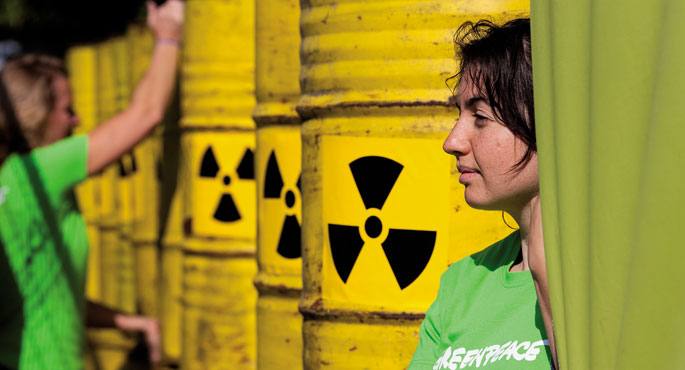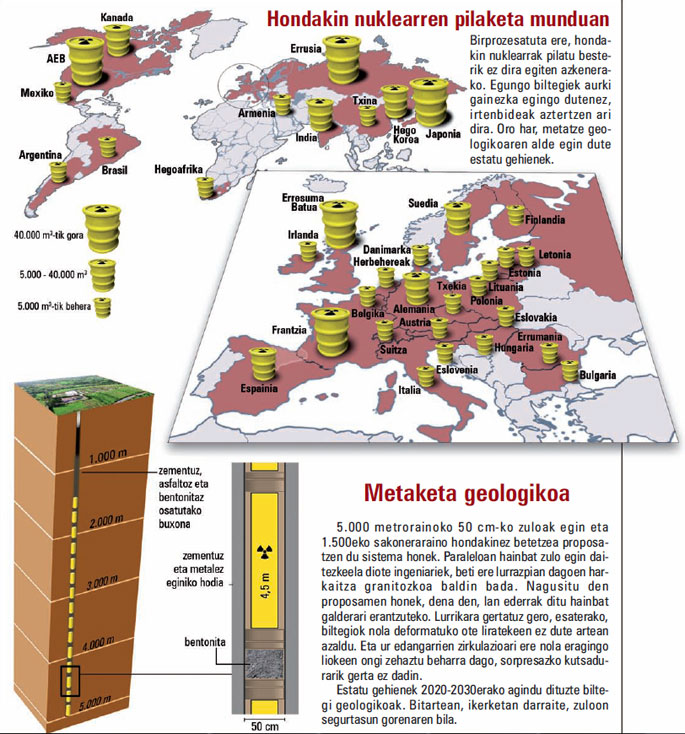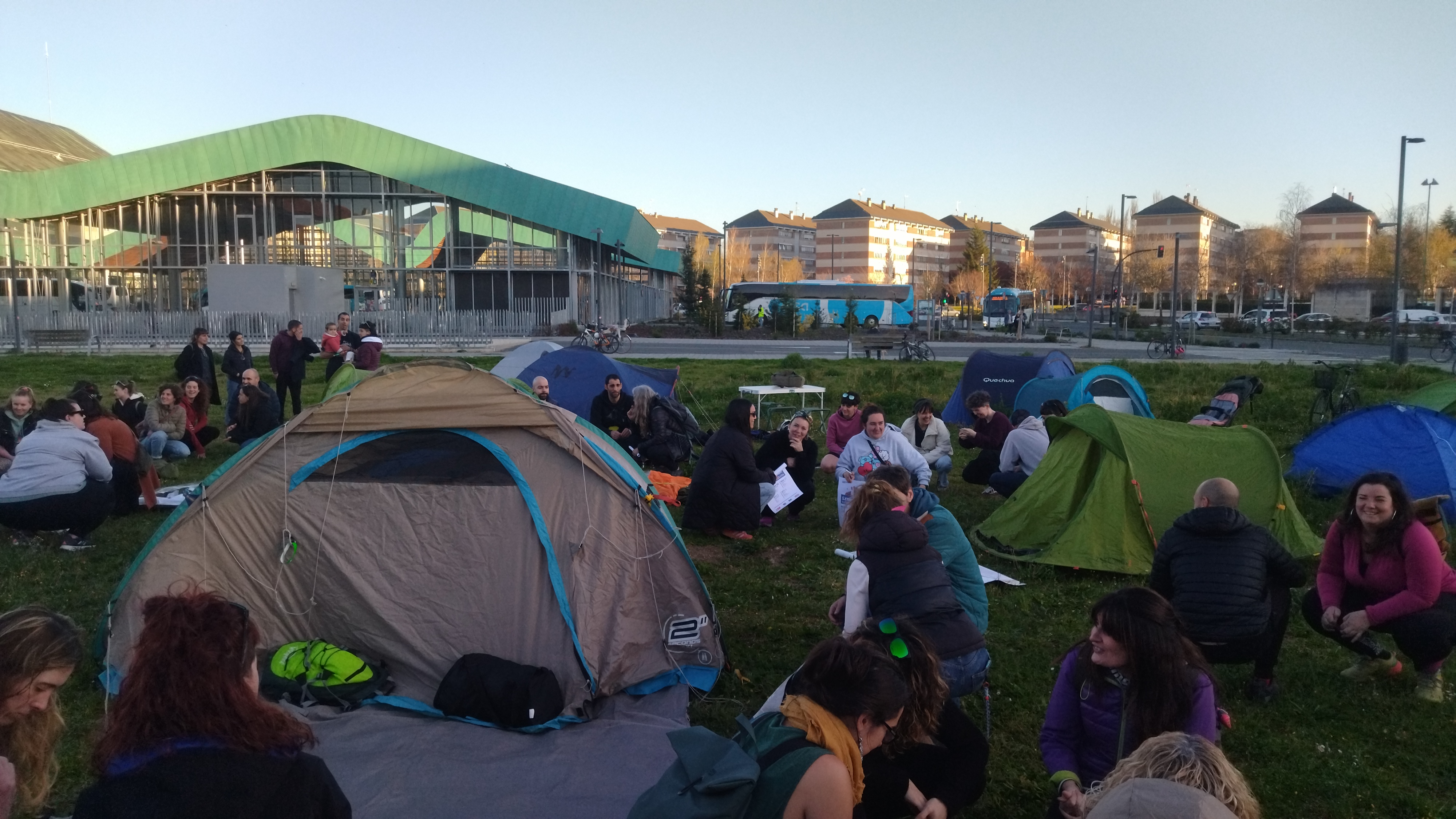That indestructible poison that is going to live billions of years.
- We have lived in balance with the radioactivity that occurs naturally since the formation of the earth. However, the artificial radiation that we are creating in recent times can cause a serious imbalance forever. For the time being, although safer systems to avoid risk have been announced, the only thing being done is to hide waste under the carpet.

Today's society is facing major challenges on the horizon in terms of environmental conservation, which, despite the great costs, will at some point have to make sense unless the world explodes: the greenhouse effect, ozone, waste management... We are still far from the system of overcoming the problems listed and the damage is already there, but we have not yet reached the limits of the irreversible. There is a solution, or something like that, that has been put in place.

Nuclear energy, on the other hand, follows the same line of generation in the single sense, since the situations or waste arising from the operation of the plants have no return. They will stay with us forever, as some (such as uranium 238) need billions of years to shut them down. Radioactive waste generated by nuclear power plants will never be waste dead, recyclable, non-hazardous, unfeasible or whatever, even if the ambiguous language used by the nuclear lobby suggests it.
Radioactive waste is a living material incompatible with our lives. And we've already accumulated a lot since World War II. The following tables reflect the amounts and characteristics of these, as well as the existing policies of Governments. For the management of radioactive waste, the most ‘aesthetic’ of the measures applied so far has been preferred, in the name of safety: the disposal of this waste from sight, i.e. the burial into holes 5,000 metres deep. The system is known as geological accumulation. Most States have taken a decision on this. Twenty years from now, a system that still needs many tests and adjustments, the waste drums will be stacked and hidden, one on top of the other, in the narrow holes made to the bone of the granite rocks, up to a depth of 1,000 meters above the earth’s surface.
Looking for the safest system
What is safety in this case? Is the system safe or, by comparison, safer than other accumulation systems? Are we sure that where it has been decided to drill there will not be a large-scale earthquake? And if that were the case, would we be sure that the granite rock is inextinguishable, even in the catastrophic, imminent and impermeable assumptions? There's no certainty, engineers will honestly corroborate this, but they will argue that radioactive effusion can hardly really happen. Fukushima will give us a new lesson, as there too it was practically impossible for such a huge tsunami to occur, so safer measures were rejected...

In this regard, barriers to nuclear energy have begun to be placed in some parts of the planet. In a recent poll, 25 million Italians (94% of voters) gave a "no resounding" to the nuclear wager that Berlusconi tried to push forward in the country. Under pressure from popular movements, Germany has promised to abandon nuclear power within ten years (2022) and has announced that 40% of electricity will be green. Switzerland will also not renew the nuclear park and plans to close it by 2034. Belgium is in the same danger...
However, the steps of the major nuclear powers are missing. The United States and Russia are still silent. In Japan, more than twenty stationary power stations are preparing to re-operate. In France, for its part, it appears that it will become the star of the presidential elections next year. D. Sarkozy accuses Hollande of wanting to return to the era of candles or increase pollution with the emission of CO2, because he has dared to talk, warm and shy, that in the coming decades he would have to try to find an alternative to nuclear. This is the picture in Europe’s most nuclear state, where energy and nuclear technologies are exported to the whole world, with huge investments and millions of jobs outstanding from this industry.
What has just been suggested by scientific journals such as Science et Vie is also significant: the existence of safe nuclear energy; in short, it would suffice to replace uranium with thorium and address the technology discarded 50 years ago in order to avoid accidents. However, they have been forgotten that this material also generates radioactive waste. In oblivion or in small letters leaves...
The lobby is not going to be resigned. Use all the means to shine even after the Fukushima spell. To do so, it will simply sweep under the carpet the poison that will pollute for billions of years.
Erradioaktibitate txikiko hondakinak. Ospitaletan eta industrian sortzen dira eta manipulazioan nahiz garraioan ez da neurri berezirik hartzen. Erabili ondoren trinkotu edo konpaktatu egiten dira, edota erre, errauskailutan. Hondakin erradioaktiboen %90 okupatzen dute bolumenari dagokionez, baina isuri erradioaktibo osoaren %1 besterik ez dute sortzen.
Erradioaktibitate ertainekoak. Hondakinok manipulatzerakoan babes berezia behar izaten da. Zentraletan zaharkituta geratu diren materialak izan ohi dira normalki. Bolumenari dagokionez, hondakin erradioaktiboen %7 dira, eta isuritako erradioaktibitate totalaren %4.
Erradioaktibitate handikoak. Erreaktore nuklearretan erabiltzen den erregaiak eta honen prozesaketatik sortutako elementuek osatzen dute multzo hau. Bolumenari dagokionez hondakin nuklear guztien %3 baino ez badira ere, isuri erradioaktiboen %95aren erantzuleak dira. Uranioa zentraletako erregai bihurtzeko prozesuan hasten da erradioaktibitate maila handitzen eta zenbait elementuren kasuan milaka milioi urte beharko dira erradioaktibitatea agortzeko
Fukushima, Japonia. 2011ko martxoan, zentral nuklearreko sei erreaktoretik hiru hondatu ziren lurrikararen eta atzetik heldutako tsunamiaren ondorioz. Material erradioaktiboa plantatik 200 miliatara ere heldu zen. Ingurumenari egiazki eginiko kaltea sekretupean da oraindik.
Txernobil, Ukraina. Zentraleko istripuaren ondorioz (1986ko apirila) Nagasaki eta Hiroshimako bonbek baino 100 aldiz erradiazio handiagoa askatu zen. 6 milioi lagun erradiatu zituela estimatzen da. Zuzenean eragindako heriotzak 4.000ko kopuruan finkatu badira ere, 93.000ra ere hel daitezke.
Mailuu-Suu, Kirgizistan. Munduko tokirik poluituenetakoa, goi mailako material erradioaktiboa prozesatzearen eta pilatzearen ondorioz (1,96 milioi metro kubiko daude gordeta mehategietan). Arrisku sismiko handiko tokia da, bestalde.
Semipalatinsk, Kazakhstan. Sobiet Batasunaren poligono militarra izan zen. Munduan leherketa nuklear gehien jasan duen tokia da. 1949an zartatu zuten lehen bonba eta 1989ra bitartean 456 proba egin ziren bertan.
Siberia, Errusia. Zuritasun ederraren pean hondakin kimikoen erresuma ezkutatzen dela dirudi. Hondakin nuklear likidoak itxi gabeko piszinetan gordetzen dira eta 125.000 tona hondakin solido ere bertan pilatzen dira lurrazpiratu gabe.
Sellafield, Erresuma Batua. Hasiera batean bonba nuklearretarako plutonioa fabrikatzen zen bertan. Ehunka istripu gertatu ziren lehen urte horietan eta milioika litro material erradioaktibo isuri dira itsasora (mendebaldeko kostaldean).
Mayak, Errusia. Ipar-ekialdeko industria gunea. Bertan zegoen planta nuklearrean istripu latza gertatu zen 1957an. 100 tona hondakin erradioaktibo askatu ziren eta Karachay lakua pozoitu zuen. 80etako hamarkadara arte isilpean gorde zuten katastrofea.
Somaliako kostaldea. Somaliako urek hondakin ugari hartu izan dute urtetan. Besteak beste, 600 kupel material erradioaktibo
eta ospitaletako hondakinak.
Mediterraneoa. Sarritan leporatu izan zaio italiar mafiako Ndrangheta sindikatuari itsasoa biltegi bilakatu izana. 1994az geroztik, urotan hondakin toxikoz betetako 40 ontzi desagertu direla aipatzen da.
Hanford, AEB. Washingtoneko gune honetan egin zen besteak beste, Fat Man, Nagasakin jaurtikitako bonba atomikoa. Estatuko hondakin erradioaktiboen bi heren pilatzen dira bertan: 53 milioi galoi hondakin likido eta 25 milioi oin kubiko hondakin solido. Lurrazpiko urak ere poluituta daude.
Hondakin erradioaktiboak kudeatu beharrak imajinazio handia eskatu die ingeniariei, urtetan. Hona hemen aztertutako (eta bertan behera utzitako) lau proiektu.
Espaziora bidaltzea. NASA agentziak hainbat hipotesi landu zituen 1977az geroztik. Besteak beste, hondakinak Lurraren orbitan betiko uztea, ilargiko kraterren batean lurperatzea, Artizarraren eta Lurraren arteko punturen batean lagatzea edota Eguzkira igortzea. Hipotesi bakoitzak, ordea, ‘baina’ esanguratsu ugari zekarren atzetik. Adibidez, AEBetan, 2003 urtera bitarteko epeari dagokionez, zentral nuklearretan pilatutako hondakinak espazioratzeko 750 hegaldi beharko ziratekeen, eta beste 104, armadak sortutakoak kanporatzeko. Gainera, kilo bat hondakin paketatzeak 50 kilo material erantsi eskatuko luke, arriskuak ekidite aldera. 1986an Challenger espazio-ontziari gertatutako istripuak eman zion amaiera ikerketa lerro honi.
Bitrifikatuz, lehergailu atomiko bilakatzea. Hondakin nuklearrez bonba nuklear bat prestatu, lurpeko harkaitz baten erdiraino jaitsi eta leherraraztea zen plana. Harkaitza hein handi batean urtu egingo litzateke, likidotu, eta hoztu ahala solidotzerakoan, elementu erradioaktibo guztiak harrapatuko lituzke bere baitan. Hipotesi hau 1996an baztertu zen, munduan saio nuklear oro gelditzeko sinatutako hitzarmenari esker.
Hego Poloko izotzen azpian lurperatzea. Hipotesi honen arabera, izotzak berak babestuko lituzke elementu erradioaktiboak –urteotako berotegi efektua ez zitzaien burutik pasatu ere egin–. Antartika babesteko hitzarmenak galarazi zien plana, 1959an sinatu zenean.
Subdukzio eremuan kokatzea. Uste denez, itsas hondoko sedimentuek txirristatik behera balihoazte bezala bidaiatzen dute Lurraren muinerantz, plaken artean daudenean. Alegia, hondakin nuklearrak plaka horietako baten ertzean jarrita, sabeleraino irentsiko lituzke Lurrak. Hipotesia frogatzeko, azterketa ugari egin zituzten mundu osoan eta gehienetan arazoa bat eta bera zen: subdukzio eremuetan jarduera bolkaniko ugari izaten denez, sumendiren bat lehertzean kraterretatik aterako litzatekeena hondakin nuklear hori bera izan zitekeen lasai asko
From linguistics or glotophobia and, of course, hatred against Basque, we have often seen our Basque become the dandruff of all sticks. Last of all, the president of Kutxabank, Anton Arriola, has been shaking our language and giving us galantas.The President of Kutxabank,
... [+]
Do not look for this connection from Ezkio or Altsasu, let alone crossing the Ebro River through Castejón. The connection, or rather the connections, between the Basque Y and the AVE of Navarre is already a reality. It is these links in the plural that should concern us and... [+]
Don't make a fuss, don't confront, don't victimize... and obey. As oppressed subjects, in this case as Basques, we talk, how many times have we had to listen to them? Ironically, two years ago, at the Euskalale Independentiston Meeting, Esne Arzallus said: "We have arrived here,... [+]




















